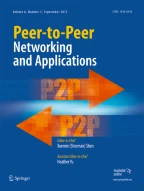Abstract
Due to the ability of sensor nodes to collaborate, time synchronization is essential for many sensor network operations. With the aid of hardware capabilities, this work presents a novel time synchronization method, which employs a dual-clock delayed-message approach, for energy-constrained wireless sensor networks (WSNs). To conserve WSN energy, this study adopts the flooding time synchronization scheme based on one-way timing messages. Via the proposed approach, the maximum-likelihood (ML) estimation of time parameters, such as clock skew and clock offset, can be obtained for time synchronization. Additionally, with the proposed scheme, the clock skew and offset estimation problem will be transformed into a problem independent of random delay and propagation delay. The ML estimation of link propagation delay, which can be used for localization systems in the proposed scenario, is also obtained. In addition to good performance, the proposed method has low complexity.
Similar content being viewed by others
Notes
In this paper, the packet is the same as the message unless otherwise stated.
References
Akyildiz I, Su W, Sankarasubramaniam Y, Cayirci E (2002) Wireless sensor networks: a survey. Comput Netw 38(4):393–422
Bulusu N, Jha S (2005) Wireless sensor networks: a systems perspective. Artech House, Norwood, MA
Hill J, Horton M, Kling R, Krishnamurthy L (2004) The platforms enabling wireless sensor networks. Commun ACM 47(6):41–46
Project Sun SPOT Homepage. http://www.sunspotworld.com. Accessed 20 November 2008
Szewczyk R, Osterweil E, Polastre J, Hamilton M, Mainwaring A, Estrin D (2004) Habitat monitoring with sensor networks. Commun ACM 6:34–40
Johnson P, Andrews D (1996) Remote continuous physiological monitoring in the home. Commun J Telemed Telecare 2:107–113
Akyildiz I, Akan O, Chen C, Fang J, Su W, Cayirci E (2003) InterPlaNetary internet: state-of-the-art and research challenges. Comput Netw 2:75–112
Burleigh S, Cerf V, Durst R, Fall K, Hooke A, Scott K, Weiss H (2002) The interplanetary internet: a communications infrastructure for Mars exploration. In: 53rd International Astronautical Congress, The Word Space Congress, Houston, Texas, Oct. 2002
Lemmerman L, Delin K, Hadaegh F, Lou M, Bhasin K, Bristow J, Connerton R, Pasciuto M (2000) Earth science vision: platform technology challenges. In: Proc. IGARSS, 2001
Li Q, De Rosa M, Rus D (2003) Distributed algorithms for guiding navigation across a sensor network. In: Proc. of Ninth Annual International Conference on Mobile Computing and Networking, San Diego, USA, Sep. 2003, pp 313–326
Want R, Hopper A, Falcao V, Gibbons J (1992) The active badge location system. ACM Trans Inf Syst 1:91–102
Werb J, Lanzl C (1998) Designing a positioning system for finding things and people indoors. IEEE Spectr 35(9):71–78
Rhee I-K, Lee J, Kim J, Serpedin E, Wu Y-C (2009) Clock synchronization in wireless sensor networks: an overview. Sensors 9:56–85
Elson J, Girod L, Estrin D (2002) Fine-grained network time synchronization using reference broadcasts. In: Proc. OSDI, 2002
Ganeriwal S, Kumar R, Srivastava M (2003) Time-sync protocol for sensor networks. In Proc. ACM SenSys, 2003, pp 138–149
Noh K-L, Chaudhari Q, Serpedin E, Suter B (2007) Novel clock phase offset and skew estimation using two-way timing message exchanges for wireless sensor networks. IEEE Trans Commun 55(4):766–777
Chaudhari Q, Serpedin E, Qaraqe K (2008) On maximum likelihood estimation of clock offset and skew in networks with exponential delays. IEEE Trans Signal Process 56(4):1685–1697
Sundararaman B, Buy U, Kshemkalyani A (2005) Clock synchronization for wireless sensor networks: a survey. Ad-Hoc Netw 3:281–323
Maroti M, Kusy B, Simon G, Ledeczi A (2004) The flooding time synchronization protocol. In: Proc. 2nd Int. Conf. Embedded Networked Sensor Systems, 2004, pp 39–49
Akhlaq M, Sheltami TR (2013) RTSP: an accurate and energy-efficient protocol for clock synchronization in WSNs. IEEE Trans Instrum Meas 62(3):578–589
Berger A, Pichler M, Klinglmayr J, Pötsch A, Springer A (2015) Low-complex synchronization algorithms for embedded wireless sensor networks. IEEE Trans Instrum Meas 64(4):1032–1042
Hightower J, Borriello G, Want R (2000) SpotON: an indoor 3D location sensing technology based on RF signal strength. Univ. of Washington, Tech. Rep. UW CSE 00-02-02, Feb. 2000
Bahl P, Padmanabhan VN (2000) RADAR: an in-building RF-based user location and tracking system. In: Proc. IEEE Joint Conf. IEEE Computer Communications Societies (INFOCOM), Tel Aviv, Israel, Mar. 2000, pp 775–784
Bergamo P, Mazzini G (2002) Localization in sensor networks with fading and mobility. In: Proc. IEEE Int. Symp. Personal, Indoor Mobile Radio Communications (PIMRC), Lisbon, Portugal, Sep. 2002, pp 750–754
Mills D (1991) Internet time synchronization: the network time protocol. IEEE Trans Commun 39(10):1482–1493
Poovendran R, Wang C, Roy S (2007) Secure localization and time synchronization for wireless sensor and ad hoc networks, 1st edn. Springer, New York
Noh K-L, Serpedin E, Qaraqe K (2008) A new approach for time synchronization in wireless sensor networks: pairwise broadcast synchronization. IEEE Trans Wirel Commun 7(9):3318–3322
Noh K-L, Wu Y-C, Qaraqe K, Suter B (2008) Extension of pairwise broadcast clock synchronization for multicluster sensor networks. EURASIP J. Adv. Signal Process 2008, article ID 286168, 10 p. doi: 10.1155/2008/286168
Syed A, Heidemann J (2005) Time synchronization for high latency acoustic networks. Tech. Rep. ISI-TR-2005-602
Abdel-Ghaffar HS (2002) Analysis of synchronization algorithm with time-out control over networks with exponentially symmetric delays. IEEE Trans Commun 50(10):1652–1661
David HA, Nagaraja HN (2003) Order statistics, 3rd edn. Wiley, New York
Acknowledgments
This work is supported in part by the grant MOST 104-2221-E-006-117, Taiwan.
Author information
Authors and Affiliations
Corresponding author
Rights and permissions
About this article
Cite this article
Lee, YR., Chin, WL.(. Low-complexity time synchronization for energy-constrained wireless sensor networks: Dual-Clock delayed-message approach. Peer-to-Peer Netw. Appl. 10, 887–896 (2017). https://doi.org/10.1007/s12083-016-0437-4
Received:
Accepted:
Published:
Issue Date:
DOI: https://doi.org/10.1007/s12083-016-0437-4
